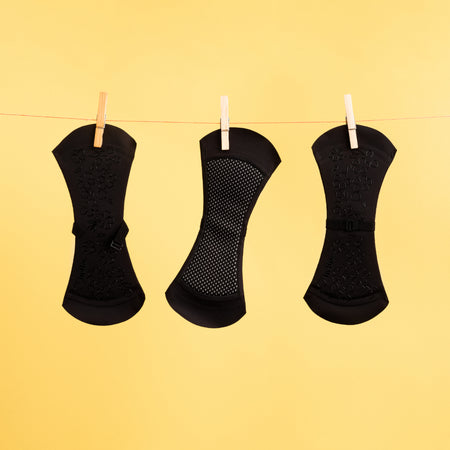You may have heard the term "endometriosis" before in reference to the reproductive health of menstruating people. You might have heard the statistic that endo affects 1 in every 10 people in the USA who menstruate. Ever wonder what it really means?
What Is Endometriosis?
Endometriosis is a condition in which tissue that typically grows inside the uterus begins to grow outside the uterus, causing pain in the pelvic region and uncomfortable, unusually heavy menstrual periods. The first signs of endo typically appear several years after an individual begins menstruation.
While the exact causes of endometriosis are still unknown, new information about the condition is becoming available. Here's what you should know about endometriosis's causes, symptoms, and risk factors.
The Stages of Endo
There are typically four stages of endometriosis identified by doctors. It's important to remember that no matter the stage of endo a person may be diagnosed with, it's not an indicator of how much or how little pain they may be in or the presence of their symptoms.
- Stage 1: the minimal presence of endo tissue, with shallow implants
- Stage 2: the mild presence of endo tissue, featuring more or deeper implants
- Stage 3: the moderate presence of endo tissue, deep implants, or cysts on the ovaries
- Stage 4: the severe presence of endo tissue with many deep implants, large cysts on one or both ovaries, and dense adhesions of tissue
Possible Symptoms of Endometriosis
Unusually heavy periods lasting longer than seven days and bleeding between are some of the most common first signs of endo. Discomfort in the bathroom (number one and number two) can also happen, especially during menstruation.
Severe menstrual cramps, painful periods, and pelvic pain, often called dysmenorrhea, are also possible symptoms. Some individuals with endo have reported lower back and upper abdominal pain.
Other symptoms associated with endometriosis are pain and swelling during or after sexual intercourse. The penetration can push or pull on the endo tissue, causing stretching and discomfort in the pelvic region. Some have also reported fatigue, gastrointestinal issues, and nausea—especially during menstruation.
Finally, one of the more significant symptoms of endometriosis can be the possibility of infertility. When endo tissue grows where it shouldn't, it can block critical reproductive organs and make it harder to get pregnant. In some cases, endo is first diagnosed by individuals who experience and seek infertility treatment.
Possible Causes of Endometriosis
As we mentioned, medical experts have not determined definitive causes of endometriosis, but there are a few theories that could explain the condition. One possible reason is thought to be retrograde menstruation, during which menstrual blood and tissue meant to be expelled during your period travel through the fallopian tubes, potentially reaching other organs in the abdominal cavity where the tissue can attach and grow.
Other possible explanations for endometriosis include embryonic cell transformation. There are billions of cells in the human body that grow into different types of tissue. It's theorised that the cells outside of the uterus can sometimes be malleable enough to transform into cells similar to the cells meant to grow inside your uterus, known as the endometrium.
Complications Caused By Endometriosis
Other than typically being a painful condition, the most common complications resulting from endometriosis are fertility issues. When tissue is growing in places it's not meant to, like, in the fallopian tubes or the lining of your pelvis, it can make getting pregnant more difficult. This is different for every person based on the amount and the location of their extra tissue, and it's important to note that endometriosis does not necessarily equal infertility. Certainly, chat with your doctor if you're concerned about this.
It's rumoured that endometriosis can cause cancer, but experts say there's no direct link between the two. Though it can lead to complications, no endometriosis traits are also identified to carry an increased risk of any type of gynaecological cancer.
Why Does Endo Cause Such Heavy Periods?
Endometriosis is often characterised by particularly heavy bleeding during menstrual periods and pain in the pelvic region. The hormones in your body—like estrogen and progesterone— cause the endometriotic tissue that grows outside the uterus to behave the same way as the tissue that forms the uterine lining during each menstrual cycle.
Once the body realises no egg has been fertilised this cycle and the lining isn't needed, hormones cause the lining of the uterus to shed, and endo tissue in other parts of the body sheds as well. This is what causes heavy bleeding and abdominal pain like cramps, aches, or throbbing.
Risk Factors for Endometriosis
There's been research conducted that suggests certain factors may increase a person's risk of developing endometriosis. On the other hand, factors have also been identified as possibly lowering a person's risk of endo.
Medical experts believe a person may be at a greater risk for endometriosis if they:
- Started menstruating at an early age
- Have menstrual cycles shorter than 27 days
- Experience heavy bleeding during menstruation (talk to your doc to decide what's heavy)
- Menstrual periods that last longer than seven days
- Have never given birth
- Have low body mass index (BMI)
- Have a relative with endometriosis
- Enter menopause early
Treatment For Endometriosis
Always speak with your doctor or medical professional for a diagnosis or treatment of any kind. They'll help you choose the best option for your and your body. Depending on the signs and symptoms, endometriosis is typically treated with medication first. If initial, less invasive treatments fail, surgery may also be an option to treat endometriosis.
















